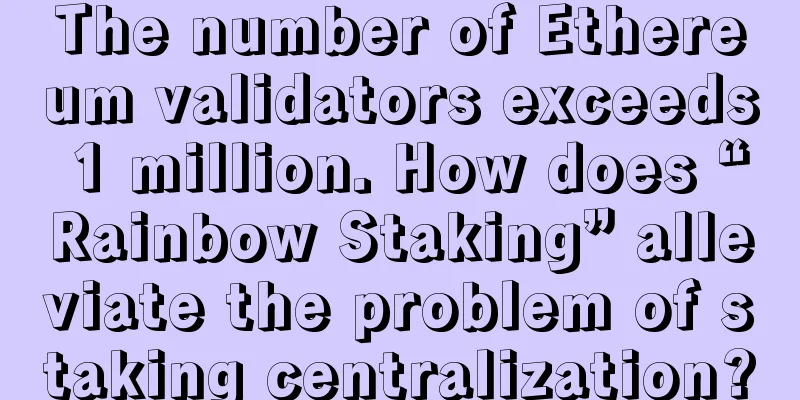The number of Ethereum validators exceeds 1 million. How does “Rainbow Staking” alleviate the problem of staking centralization?

|
“Anti-correlated incentives” proposal Although Vitalik Buterin recognizes the advantages that large validators provide to the Ethereum network, he still tries to strike a balance between large validators and the requirements of a decentralized and resilient network. On March 27, he proposed an innovative plan of "anti-correlated incentives" to address the problem of centralization among validators, increase penalties for failures of large validators, and enhance the decentralization and fairness of the Ethereum staking mechanism. Correlated failures on the Ethereum network can result from the control of multiple validators from a single location, undermining the decentralized nature of the system. To address this, the “anti-correlated incentives” scheme will penalize validators for correlated failures, incentivizing them to expand the scope of their validator activity. Vitalik Buterin believes that if multiple validators controlled by the same entity fail together, they will be subject to higher penalties than if a single validator fails, because any mistake made by a large validator will be replicated across all identities it controls. For example, validators in the same cluster (such as a staking pool) are more likely to experience correlated failures, perhaps due to shared infrastructure. The proposal proposes to penalize validators that deviate from the average failure rate. If many validators fail in a given slot, the penalty for each failure will be higher. Simulations show that this approach could reduce the advantage of large Ethereum staking platforms, as large entities are more likely to cause spikes in failure rates due to correlated failures. Potential benefits of the proposal include incentivizing decentralization by establishing separate infrastructure for each validator and making solo staking more economically competitive relative to staking pools. Beyond that, Vitalik Buterin also proposed other options, such as different penalty schemes to minimize the advantages of large validators and examine the impact on geographic and client decentralization. While Ethereum has penalty mechanisms such as slashing to deal with serious violations, these mechanisms are usually used to deal with extremely malicious or serious behavior. This proposal incorporates penalties into regular network operations and emphasizes promoting real diversity among validators. The purpose of this strategy is to ensure that efforts to increase decentralization promote substantive changes rather than just superficial compliance. |
<<: AI Token Price Surge: Is It Just Hype or Is There Real Potential?
>>: What caused Bitcoin to fall back to $66,000?
Recommend
What is a short nose in physiognomy?
Do people with short noses have bad fate? Actuall...
How to read your fortune through palmistry
There are many lines on our hands. Our ancestors ...
What are the facial features of people who are easy to be picked up?
Marriage is a necessary path for young men and wo...
Phrenology Illustrated Encyclopedia: Golden Lock Cross Bones
Physiognomy is a type of physiognomy and a way fo...
What are the characteristics of getting rich after the age of 30?
I don’t know if you have noticed in life that som...
Web3, does it have anything to do with us?
Web3 has become very popular these days. First, H...
ICE Charges Payza and Two Canadian Citizens with Using Bitcoin for Money Laundering
This week, the U.S. Immigration and Customs Enfor...
Yuki, Vice President of New Color Technology: Mining has begun to become a long-term investment
Yuki, vice president of New Color Technology, rec...
Analysis of the three facial features of women born with a miserable life
As one of the traditional physiognomy techniques, ...
Bitcoin wins buying wave on Thanksgiving: breaking through $8,700 to set a new record high
Bitcoin climbed to $8,700, a record high, as inve...
Do you know what the characteristics of a person who is unlucky in marriage and a person who is unlucky in wife are?
Physiognomy is one of the three major traditional...
Is it a good fate for a woman with enlarged nose wings?
Many people will lament why they never encounter ...
Blockchain sets off a global craze and hopes to redefine Internet finance
According to foreign media reports, Microsoft rec...
El Salvador’s President: Bitcoin wallets in El Salvador will be 100% operational in the next few days
El Salvador’s Chivo cryptocurrency wallet will so...
How to look at facial features
Face reading is a widely used fortune-telling sci...









